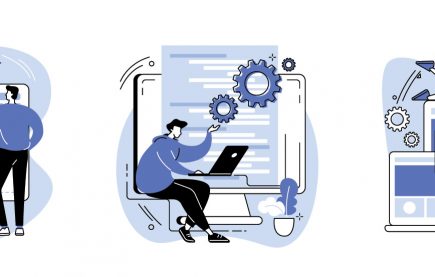
Why Companies Are Shifting Focus Toward Website Accessibility
Accessibility has become an increasing concern for businesses over the past few decades. This can only be a good thing for everyone involved. For consumers, it means more equitable access to a full range of goods, services, and experiences. For companies, it offers opportunities for more meaningful connections with a wider range of clients.
Until relatively recently, most accessibility efforts were geared toward improving physical environments. Purely online companies were often slow to make adjustments, aside from supporting employees in office and warehouse spaces. However, more business-to-business (B2B) eCommerce enterprises are recognizing that their digital tools must conform to higher inclusivity standards. This has prompted a greater industry-wide commitment to assessing materials and making changes accordingly.
We’re going to examine this shift toward website accessibility a little more closely. Why are businesses making changes, and in which areas should your company focus its attention?
Legal Responsibility
One of the first factors to consider is how web accessibility affects a business’s legal responsibilities. Most companies are already aware that their physical environment must meet the standards of the Americans With Disabilities Act (ADA). Yet too many still overlook the fact that these regulations also apply to a range of digital environments and assets.
Title III of the ADA specifically prohibits companies from discriminating against people with disabilities. In essence, this means that businesses must ensure equal access to all goods and services to all who want to access them. If you’re offering online services, you must ensure reasonable accommodations are in place to address any hurdles to usability. This applies to digital tools used by clients and those accessed by your staff.
Businesses that don’t prioritize web accessibility can face lawsuits from users and legal action from the U.S. Department of Justice (DoJ). There have already been several examples of this. For instance, Rite Aid settled with the US Department of Justice, agreeing to address compliance issues with its online vaccine portal. If companies fail to meet the standards outlined in such settlements, they may be required to pay compensation, among other penalties.
Ethical Duty
Ensuring web accessibility is not only a legal requirement. One of the main reasons companies should target this area is to maintain high ethical standards. When a business prioritizes inclusivity in its online materials, it sends a distinct message about the business’s values.
This isn’t just a vital way to demonstrate your ethical commitment to your consumers. It also sets standards for all those interacting with your organization. Employees gain a better understanding of how your company’s actions can improve people’s experiences. As a result, this can influence their behavior both at work and in their personal lives. Industry partners notice that your business puts significant focus on equality, which can in turn encourage wider adoption of better standards.
Keep in mind that simply maintaining ADA standards isn’t necessarily a demonstration of high ethics. After all, these are the minimum actions companies are expected to take in order to be legally compliant. A true commitment to inclusivity requires businesses to go above and beyond these standards to ensure the best outcomes for everyone involved.
Customer Experience
Another reason to focus on website accessibility is its impact on the customer experience. The rise of the digital landscape has given more businesses access to a truly global marketplace. While this can extend your company’s reach, it can also mean a steep increase in competition. The companies that rise to the top are usually those that can offer their consumers the best possible online experience.
Usability is a significant aspect of the customer experience in online spaces. Your consumers must be able to easily navigate and utilize your website, and if they can’t, they’re likely to choose a competitor whose website is more accessible.
Plan your customer experience around accessibility. Creating customer journey maps can help you effectively visualize the steps your consumers will take as they use your website. This involves researching your target demographics and establishing key touchpoints in their engagement with you. Approaching this task with an accessibility-first perspective enables you to recognize potential hurdles in the journey. You can then design your website to provide a high-quality experience for as many consumers as possible.
Brand Reputation
In a competitive business environment, a brand’s reputation is a powerful influencer. It helps you to attract new clients, improve long-term loyalty, and strengthen consumer engagement. In some ways, it can also enable you to justify higher prices for your goods and services. The level of your commitment to website accessibility can significantly impact your brand reputation.
This is because consumers are increasingly making purchasing decisions based on how businesses conduct their operations. One recent study found that 46% of consumers pay close attention to a brand’s social responsibility efforts. Indeed, customers are savvier today about what makes a site problematic for those living with disabilities and other accessibility challenges. They’re also likely to express their opinions about non-compliant sites on social media.
It’s vital that your brand continues to bolster its good reputation with a commitment to inclusivity. Conduct regular accessibility audits to make sure your website is meeting or even exceeding standards. Communicate with your consumers about your efforts, both on your website and on your social media channels. Wherever possible, include your consumers in your efforts by inviting them to send you concerns, issues, or suggestions.
Vision Challenges
Web accessibility involves different elements than those required in physical stores or office environments. One of your primary goals should be reducing hurdles for those experiencing vision challenges. According to the Centers for Disease Control and Prevention (CDC), more than 3 million people in the U.S. have vision impairments, with an additional 8.2 million experiencing a refractive error. This means that a significant percentage of consumers may have difficulty viewing websites properly.
The most basic form of vision accessibility involves your font choices. Make sure that the fonts you use are simple, easily readable types, like Times New Roman, Tahoma, or Helvetica. Your visitors should be able to easily change the font size on your site to fit their needs. It’s also important that your fonts are readable on portable devices and screen readers.
Remember, too, that potential impairments aren’t limited to the quality of vision. Color blindness can also affect website accessibility, especially when the contrast between the text and the page background isn’t distinct enough. This is why plain white backgrounds are usually recommended for sections with text. Work with your web designer to ensure that the contrast meets the web accessibility guidelines of 4.5:1 for normal text and 3:1 for large text.
Neurodivergent Traits
Another commonly overlooked aspect of web accessibility is accommodating consumers with neurodivergent traits. Neurodivergence describes a range of neurological differences people live with, such as autism spectrum disorder (ASD), dyslexia, and developmental coordination disorder (DCD). Neurodivergent people may absorb information differently than neurotypical people, so digital or online resources should be structured around their needs.
For example, videos and podcasts you use in your marketing campaigns and on your website must have accurate text captions rather than relying on audio alone. When these materials are embedded on your site, visitors must be able to pause and rewind them to review at a pace they’re comfortable with.
People with neurodivergent traits may also find some forms of audio-visual stimuli to be overwhelming or stressful. Minimize potentially disruptive assets by limiting the use of flashing images, jarring color palettes, and loud music. Make sure video or audio elements don’t autoplay when visitors land on a page or scroll through your content. Neurodivergent visitors should feel empowered to interact with your content according to their needs.
Conclusion
The shift toward greater accessibility on B2B websites and online materials can only be a good thing. Companies are not just adjusting to meet their legal and ethical responsibilities. They are realizing clear reputational and customer experience benefits. It’s also important for businesses to focus on improvements most relevant to online materials, such as accommodations for those living with visual impairments and neurodivergent traits. With a consistent and continued focus on accessibility, the B2B eCommerce landscape can be a positive influence on everyone involved.
If you’re looking for help in creating an accessible website experience for your audience, contact the B2B website experts at Lform! We’ll provide a free consultation to determine your audience’s needs and challenges so you can ensure your message is communicated perfectly to all of your intended users.



